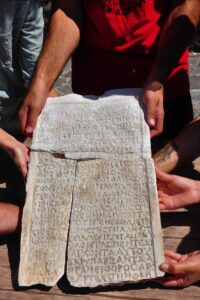 An 1,800-year-old inscription on a marble slab unearthed in the ancient city of Aigai in western Turkey reveals a beef with Rome over goat skin taxes. The slab was discovered broken into three pieces in a 2005 excavation of Aigai’s bouleuterion (the assembly hall of the council of citizens that governed Greek city-states), but has only been fully deciphered now.
An 1,800-year-old inscription on a marble slab unearthed in the ancient city of Aigai in western Turkey reveals a beef with Rome over goat skin taxes. The slab was discovered broken into three pieces in a 2005 excavation of Aigai’s bouleuterion (the assembly hall of the council of citizens that governed Greek city-states), but has only been fully deciphered now.
Located in the Yund Mountain Range less that 10 miles inland from the Aegean coast, Aigai was founded around 700 B.C. by Greek colonists. An important trade route wound through the mountain valley connecting Lydia and Anatolia, and the colonists built Aigai on the valley to control the lucrative pass. The Greek word “aiga” means goat, and goats thrived in the mountainous terrain. The newly-deciphered inscription underscores the significance of the animal to the city named after it. Goats were so critical to Aigai’s prosperity that when Roman tax farmers got too greedy, the council of citizens was driven to petition the emperor himself. Sending an emissary to the emperor in Rome was not a small matter. One does not just walk into Mordor, as the saying goes, and it took a great deal of money and effort to get a petition heard.
In the inscription, it is stated that the people of Aigai sent an envoy named ‘Fortunatus’ to the Roman emperor, reporting their complaint about the different collection of taxes from goat skin by each collector and demanding that this situation be resolved. It turned out that the Roman Emperor, who took into account the complaints and demands of the Aigai people, fixed the taxes taken from goat skin at a rate of 1 in 6 and stated that he would punish the tax collectors who did not comply with this rule. […]
[Excavation leader Professor Yusuf] Sezgin continued: “Aigai literally means goat. Its geography is suitable for goat breeding. For the first time, we have come to a situation where we can confirm this with an inscription. It is an inscription written 1800 years ago and it was placed in the parliament. Determining the taxes collected by the Roman emperors and fixing them must be one of the most important issues of the city. The inscription confirmed our theories that the city’s economy was based on goat skin. In this respect, it is an important inscription that we have just presented to the world of science.”